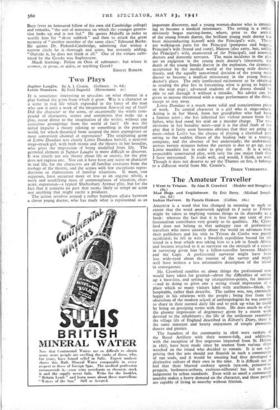Two Plays
IT is sometimes interesting to speculate on what element in a play formed the germ from which it grew. Was it a character or a scene in real life which expanded in the fancy of the man who saw it until a work of the imagination flowered out of fact? Did the character or the scene, or occasionally the whole com- pound of characters, scenes and sentiments that make up, a play, occur direct to the imagination of the writer, without any conscious promptings from the world of fact? Or was the initial impulse a theory relating to something in the practical world, for which theatrical form secured the most appropriate or most convenient channel of expression? The originating germ of Lottie Dundass was clearly Lottie Dundass herself, a neurotic stage-struck girl, with both mania and the theatre in her heredity, who gives the impression of being modelled from life. The germinal element in lupiter Laughs is more difficult to discover. It was clearly not any theory about life or society, for the play does not express one. Nor can it have been any scene or character in real life, for the characters are all familiar creatures from the zoology of the theatre, and the scenes with few exceptions repro- ductions or elaborations of familiar situations. It must, one supposes, have occurred more or less as an organic whole, a sorry and unedifying mass of commonplaces of situation, char- acter, expression—a typical Shaftesbury Avenue play, but for the fact that it contains no part that seems likely to tempt an actor nor anything that might excite a producer.
The action revolves around a rather humdrum afiaire between a clever young doctor, who has made what is represented as an
important discovery, and a young woman-doctor who is intend- ing to become a medical missionary. The setting is a rather obviously bogus nursing-home, where, prior to the arrival of the young female doctor, the brilliant young male doctor has been misconducting himself with the Principal's wife. There are walking-on parts for the Principal (pompous and bogus), Principal's wife (bored and catty), Matron (also catty, but, unlike the Principal's wife, enamoured of the Principal), and assorted doctors and domestic servants. The main incidents in the plot are an explosion in the young male doctor's laboratory, the death of the young female doctor in the explosion, the dramatic acceptance by the medical world of the young male doctor's theory, and the equally sensational decision of the young male doctor to become a medical missionary in the young female doctor's place. The only intellectual excitement to be obtained in reading the play lies in forecasting what is going to happen on the next page ; advanced students of the drama should be able to sail through it without a mistake. No advice can be given to anyone threatened with a stage performance of the thing, except to stay away.
Lottie Dundass is a much more solid and conscientious piece
of work. Its central character is a girl who is stage-struck. Acting is in her blood, from her grandfather who had been a famous actor ; she has inherited her violent nature from her father, who had stood his trial on a murder charge. The two elements in her heredity meet—and it is the chief fault of the play that it fairly soon becomes obvious that they are going to meet—when Lottie has the chance of playing a cherished part owing to the sudden illness of the leading lady in a touring company, and the absence of her understudy; the understudy arrives twenty minutes before the curtain is due to go up, and Lottie murders her in order to play the part. It is a solid, respectably constructed play, with only the one major fault that I have mentioned. It reads well, and would, I think, act well. Though it does not deserve to set the Thames on fire, it belongs to a different world from Mr. Cronin's.
DEREK VERSCHOYLE.






























 Previous page
Previous page